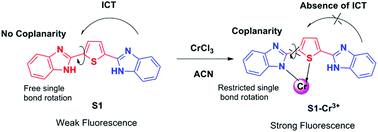Coplanarity driven fluorescence turn-on sensor for chromium(iii) and its application for bio-imaging†
Abstract
New benzimidazole and benzothiazole derivatives (S1–S3) derived from thiophene-2,5-dicarboxaldehyde and 5,5′-bipyridyldicarboxaldehyde with NSN/SSS/NN binding sites were tested against various cations and anions. S3 showed selectivity toward copper(II) ions among other cations under consideration with the colour change to pale yellow from colourless under aqueous medium. In the cases of S1 and S2, no colour change was observed. S1 alone showed selective fluorescence turn on for Cr(III) ions among other cations. S1 showed sensitivity towards Cr(III) with fluorescence change with bathochromic shift. The prominent fluorescence change of S1 with Cr(III) ions was applied to live cell imaging of HeLa cells.



 Please wait while we load your content...
Please wait while we load your content...